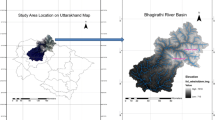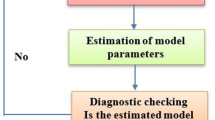Abstract
In this paper, we propose a hybrid model that combines wavelet transform and artificial neural networks (ANN) to forecast the time series of hourly average methane (CH4) concentration. In this work, we want to improve the accuracy of predicting the dynamics of changes in the surface concentration of CH4. The model is based on data from environmental monitoring of greenhouse gases on the Belyy Island of the Yamal-Nenets Autonomous Okrug, Russia. The initial data for building the proposed model were obtained in the period July–August 2017. The time series of the CH4 concentration was decomposed using a discrete wavelet transform into five components—one approximating and four detailing components. These five components, together with synchronized series of meteorological parameters (temperature, humidity, and pressure), were used to train ten ANNs—five autoregressive networks with exogenous input (NARX) and five recurrent neural networks (Elman). The forecast was calculated as the sum of the forecasts for each of the five components. The forecast accuracy was assessed using several indices and a Taylor chart. The hybrid approach improved the accuracy of the forecasts by more than 20%. The hybrid model based on the NARX shown the best accuracy.







Similar content being viewed by others
References
IPCC 2006 Guidelines for national greenhouse gas inventories. Prepared by the National Greenhouse Gas Inventories Programme. IGES, Hayama
IPCC (2019) Refinement to the 2006 IPCC guidelines for national greenhouse gas inventories. Kyoto, Hayama
Kennedy C, Steinberger J, Gasson B et al (2009) Greenhouse gas emissions from global cities. Environ Sci Technol 43:7297–7302. https://doi.org/10.1021/es900213p
Szulejko JE, Kumar P, Deep A, Kim K-H (2017) Global warming projections to 2100 using simple CO2 greenhouse gas modeling and comments on CO2 climate sensitivity factor. Atmos Pollut Res 8(1):136–140. https://doi.org/10.1016/j.apr.2016.08.002
Kuklinska K, Wolska L, Namiesnik J (2015) Air quality policy in the U.S. and the EU—a review. Atmos Pollut Res 6(1):129–137. https://doi.org/10.5094/apr.2015.015
Hegerl GC, Hasselmann K, Cubasch U et al (1997) Multi-fingerprint detection and attribution analysis of greenhouse gas, greenhouse gas-plus-aerosol and solar forced climate change. Clim Dyn 13(9):613–634. https://doi.org/10.1007/s003820050186
Hein R, Crutzen PJ, Heimann M (1997) An inverse modeling approach to investigate the global atmospheric methane cycle. Glob Biogeochem Cycles 11(1):43–76. https://doi.org/10.1029/96gb03043
Johns TC, Gregory JM, Ingram WJ et al (2003) Anthropogenic climate change for 1860 to 2100 simulated with the HadCM3 model under updated emissions scenarios. Clim Dyn 20(6):583–612. https://doi.org/10.1007/s00382-002-0296-y
Smith SJ, Pitcher H, Wigley TM (2001) Global and regional anthropogenic sulfur dioxide emissions. Glob Planet Change 29(1–2):99–119. https://doi.org/10.1016/s0921-8181(00)00057-6
Allen MR, Stott PA, Mitchell JFB et al (2000) Quantifying the uncertainty in forecasts of anthropogenic climate change. Nature 407:617–620
Guo M, Hu Y, Yu J (2019) The role of financial development in the process of climate change: Evidence from different panel models in China. Atmos Pollut Res 10(5):1375–1382. https://doi.org/10.1016/j.apr.2019.03.006
Vargin PN, Yushkov VA, Khaikin SM et al (2010) Climate change and the middle atmosphere: increasingly more questions. Herald Russ Acad Sci 80(1):47–56. https://doi.org/10.1134/s1019331610010065
Fang SX, Zhou LX, Tans PP et al (2014) In situ measurement of atmospheric CO2 at the four WMO. Atmos Chem Phys 14:2541–2554. https://doi.org/10.5194/acp-14-2541-2014
Barlow JM, Palmer PI, Bruhwiler LM, Tans P (2015) Analysis of CO2 mole fraction data: first evidence of large-scale changes in CO2 uptake at high northern latitudes. Atmos Chem Phys 15:13739–13758. https://doi.org/10.5194/acp-15-13739-2015
Graven HD, Keeling RF, Piper SC et al (2013) Enhanced seasonal exchange of CO2 by Nothern ecosystems since 1960. Science 341:1085–1089. https://doi.org/10.1126/science.1239207
Stehlík M, Aguirre P, Girard S, Jordanova P, Kiseľák J, Torres S et al (2017) On ecosystems dynamics. Ecol Complex 29:10–29. https://doi.org/10.1016/j.ecocom.2016.11.002
Stehlík M, Dušek J, Kiseľák J (2016) Missing chaos in global climate change data interpreting? Ecol Complex 25:53–59. https://doi.org/10.1016/j.ecocom.2015.12.003
Ardalani-Farsa M, Zolfaghari S (2010) Chaotic time series prediction with residual analysis method using hybrid Elman–NARX neural networks. Neurocomputing 73:2540–2553. https://doi.org/10.1016/j.neucom.2010.06.004
Park YR, Murray TJ, Chen C (1996) Predicting sun spots using a layered perceptron neural network. IEEE Trans Neural Netw 1(2):501–505. https://doi.org/10.1109/72.485683
Zhang J, Chung HS, Lo W (2008) Chaotic Time series prediction using a neurofuzzy system with time-delay coordinates. IEEE Trans Knowl Data Eng 20(7):956–964. https://doi.org/10.1109/TKDE.2008.35
Ma Q-L, Chen W-B (2013) Modular state space of echo state network. Neurocomputing 122:406–417. https://doi.org/10.1016/j.neucom.2013.06.012
Menezes JM, Barreto GA (2008) Long-term time series prediction with the NARX network: an empirical evaluation. Neurocomputing 71:3335–3343. https://doi.org/10.1016/j.neucom.2008.01.030
Rojas I, Valenzuelab O, Rojasa F, Guillena A, Herreraa LJ, Pomaresa H, Marquezb L, Pasadasb M (2008) Soft-computing techniques and ARMA model for time series prediction. Neurocomputing 71:519–537. https://doi.org/10.1016/j.neucom.2007.07.018
Sapankevych N, Sankar R (2009) Time series prediction using support vector machines: a survey. IEEE Comput Intell Mag 4(2):24–38. https://doi.org/10.1109/MCI.2009.932254
Gholipour A, Araabi BN, Lucas C (2006) Predicting chaotic time series using neural and neurofuzzy models: a comparative study. Neural Process Lett 24:217–239. https://doi.org/10.1007/s11063-006-9021-x
Kodogiannis V, Lolis A (2002) Forecasting financial time series using neural network and fuzzy system-based techniques. Neural Comput Appl 11:90–102. https://doi.org/10.1007/s005210200021
Izonin I, Tkachenko R, Verhun V, Zub K (2020) An approach towards missing data management using improved GRNN-SGTM ensemble method. Eng Sci Technol Int J. https://doi.org/10.1016/j.jestch.2020.10.005
Tkachenko R, Izonin I, Dronyuk I, Logoyda M, Tkachenko P (2020) Recovery of missing sensor data with GRNN-based cascade scheme, international journal of sensors. Wirel Commun Control 10:1. https://doi.org/10.2174/2210327910999200813151904
Tkachenko R, Izonin I, Kryvinska N, Dronyuk I, Zub K (2020) An approach towards increasing prediction accuracy for the recovery of missing IoT data based on the GRNN-SGTM ensemble. Sensors 20(9):2625. https://doi.org/10.3390/s20092625
Wunsch A, Liesch T, Broda S (2018) Forecasting groundwater levels using nonlinear autoregressive networks with exogenous input (NARX). J Hydrol 567:743–758. https://doi.org/10.1016/j.jhydrol.2018.01.045
Hussain S, AlAlili A (2017) A hybrid solar radiation modeling approach using wavelet multiresolution analysis and artificial neural networks. Appl Energy 208:540–550. https://doi.org/10.1016/j.apenergy.2017.09.100
Liu H, Wu H, Lv X, Ren Z, Liu M, Li Y, Shi H (2019) An intelligent hybrid model for air pollutant concentrations forecasting: case of Beijing in China. Sustain Cities Soc 47:101471. https://doi.org/10.1016/j.scs.2019.101471
Liu H, Mi X, Li Y (2018) Wind speed forecasting method based on deep learning strategy using empirical wavelet transform, long short term memory neural network and Elman neural network. Energy Convers Manag 156:498–514. https://doi.org/10.1016/j.enconman.2017.11.053
Ruiz LGB, Rueda R, Cuéllar MP, Pegalajar MC (2018) Energy consumption forecasting based on Elman neural networks with evolutive optimization. Expert Syst Appl 92:380–389. https://doi.org/10.1016/j.eswa.2017.09.059
Chen X, Chen X, She J, Wu M (2017) A hybrid time series prediction model based on recurrent neural network and double joint linear–nonlinear extreme learning network for prediction of carbon efficiency in iron ore sintering process. Neurocomputing 249:128–139. https://doi.org/10.1016/j.neucom.2017.03.069
Lan H, Zhang C, Hong Y-Y, He Y, Wen S (2019) Day-ahead spatiotemporal solar irradiation forecasting using frequency-based hybrid principal component analysis and neural network. Appl Energy 247:389–402. https://doi.org/10.1016/j.apenergy.2019.04.056
Adamowski J, Chan HF (2011) A wavelet neural network conjunction model for groundwater level forecasting. J Hydrol 407(1–4):28–40. https://doi.org/10.1016/j.jhydrol.2011.06.013
Ebrahimi H, Rajaee T (2017) Simulation of groundwater level variations using wavelet combined with neural network, linear regression and support vector machine. Glob Planet Change 148:181–191. https://doi.org/10.1016/j.gloplacha.2016.11.014
Kalteh AM (2013) Monthly river flow forecasting using artificial neural network and support vector regression models coupled with wavelet transform. Comput Geosci 54:1–8. https://doi.org/10.1016/j.cageo.2012.11.015
Graf R, Zhu S, Sivakumar B (2019) Forecasting river water temperature time series using a wavelet–neural network hybrid modelling approach. J Hydrol. https://doi.org/10.1016/j.jhydrol.2019.124115
Siwek K, Osowski S (2012) Improving the accuracy of prediction of PM10 pollution by the wavelet transformation and an ensemble of neural predictors. Eng Appl Artif Intell 25(6):1246–1258. https://doi.org/10.1016/j.engappai.2011.10.013
Chen Y, Shi R, Shu S, Gao W (2013) Ensemble and enhanced PM10 concentration forecast model based on stepwise regression and wavelet analysis. Atmos Environ 74:346–359. https://doi.org/10.1016/j.atmosenv.2013.04.002
Feng X, Li Q, Zhu Y, Hou J, Jin L, Wang J (2015) Artificial neural networks forecasting of PM 2.5 pollution using air mass trajectory based geographic model and wavelet transformation. Atmos Environ 107:118–128. https://doi.org/10.1016/j.atmosenv.2015.02.030
Dunea D, Pohoata A, Iordache S (2015) Using wavelet–feedforward neural networks to improve air pollution forecasting in urban environments. Environ Monit Assess 187(7):477. https://doi.org/10.1007/s10661-015-4697-x
Bai Y, Li Y, Wang X, Xie J, Li C (2016) Air pollutants concentrations forecasting using back propagation neural network based on wavelet decomposition with meteorological conditions. Atmos Poll Res 7(3):557–566. https://doi.org/10.1016/j.apr.2016.01.004
Cabaneros SM, Calautit JK, Hughes B (2020) Spatial estimation of outdoor NO2 levels in Central London using deep neural networks and a wavelet decomposition technique. Ecol Modell 424:109017. https://doi.org/10.1016/j.ecolmodel.2020.109017
Osowski S, Garanty K (2007) Forecasting of the daily meteorological pollution using wavelets and support vector machine. Eng Appl Artif Intell 20(6):745–755. https://doi.org/10.1016/j.engappai.2006.10.008
Su X, An J, Zhang Y, Zhu P, Zhu B (2020) Prediction of ozone hourly concentrations by support vector machine and kernel extreme learning machine using wavelet transformation and partial least squares methods. Atmos Poll Res 11(6):51–60. https://doi.org/10.1016/j.apr.2020.02.024
Mallat S (1989) A theory for multiresolution signal decomposition: the wavelet representation. IEEE Trans Pattern Anal Mach Intell 11:674–693. https://doi.org/10.1109/34.192463
Daubechies I (1988) Ten lectures on wavelets. SIAM Press, Philadelphia
Lazorenko OV, Lazorenko SV, Chernogor LF (2002) Application of wavelet analysis to problem of ultra-wideband signal detection on noise background. Radio Phys Radio Astron 7(1):46–63 ((in Russian))
Buevich A, Sergeev A, Shichkin A, Baglaeva E (2020) A two-step combined algorithm based on NARX neural network and the subsequent prediction of the residues improves prediction accuracy of the greenhouse gases concentrations. Neural Comput Appl. https://doi.org/10.1007/s00521-020-04995-4
Kiseľák J, Lu Y, Švihra J, Szépe P, Stehlík M (2020) “SPOCU”: scaled polynomial constant unit activation function. Neural Comput Appl. https://doi.org/10.1007/s00521-020-05182-1
Willmott CJ (1981) On the Validation of Models. Phys Geogr 2:184–194
Willmott CJ, Robeson SM, Matsuura K (2011) A refined index of model performance. Int J Climatol 13:2088–2094
Taylor K (2001) Summarizing multiple aspects of model performance in a single diagram. J Geophys Res 106:7183–7192. https://doi.org/10.1029/2000JD900719
Acknowledgements
Authors want to thank the editor and anonymous reviewers for their constructive comments that contributed to improving the paper and for new ideas for further development.
Author information
Authors and Affiliations
Corresponding author
Ethics declarations
Conflict of interest
Authors declare that there is no conflict of interests regarding the publication of this paper.
Additional information
Publisher's Note
Springer Nature remains neutral with regard to jurisdictional claims in published maps and institutional affiliations.
Rights and permissions
About this article
Cite this article
Rakhmatova, A., Sergeev, A., Shichkin, A. et al. Three-day forecasting of greenhouse gas CH4 in the atmosphere of the Arctic Belyy Island using discrete wavelet transform and artificial neural networks. Neural Comput & Applic 33, 10311–10322 (2021). https://doi.org/10.1007/s00521-021-05792-3
Received:
Accepted:
Published:
Issue Date:
DOI: https://doi.org/10.1007/s00521-021-05792-3




